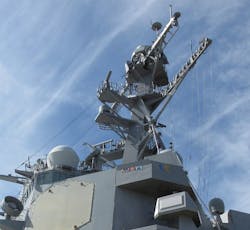Navy orders additional SEWIP Block 2 shipboard electronic warfare (EW) systems from Lockheed Martin
Officials of the Naval Sea Systems Command in Washington are exercising options with the Lockheed Martin Corp. Rotary and Mission Systems segment in Liverpool, N.Y., for full-rate production of Surface Electronic Warfare Improvement Program (SEWIP) Block 2 subsystems (AN/SLQ-32(V)6).
SEWIP Block 2 is an evolutionary acquisition and incremental development program to upgrade the existing AN/SLQ-32(V) electronic warfare system.
SEWIP provides enhanced shipboard EW for early detection, analysis, threat warning, and protection from anti-ship missiles. SEWIP Block 2 will enhance the shipboard EW systems's receiver and antenna group to meet the latest threats.
Lockheed Martin won a $148.9 million contract last October for full-rate production of AN/SLQ-32A(V)6) and AN/SLQ-32C(V)6 SEWIP shipboard EW systems. Before that, Lockheed Martin won a Navy award for SEWIP Block 2 in late 2009, leading a team of ITT Electronic Systems (now Harris Corp.), Cobham Defence Electronic Systems, Research Associates Syracuse, and Azure Summit Technology of Fairfax, Va.
Since the SEWIP program started in 2002, General Dynamics Advanced Information Systems (AIS) in Fairfax, Va., acted as prime contractor for SEWIP blocks 1A, 1B1, 1B2, and 1B3.
The Lockheed Martin Block 2 SEWIP design is based on its integrated common electronics warfare system (ICEWS), which enables rapid reconfiguring of the system with commercial technology.
Mercury Systems in Chelmsford, Mass., is providing advanced radio frequency (RF) microwave tuners and intermediate frequency (IF) products for SEWIP Block 2. Lockheed Martin chose the Mercury Echotek series microwave tuner and digital receiver, which are optimized for fast tuning and high performance, Mercury officials say.
Developed by Raytheon in the 1970s, the original AN/SLQ-32 systems employed passive radar technology for early warning, identification and tracking of enemy threats. Subsequent upgrades provided an additional active capability for simultaneous jamming of several different threats.
On Friday's contract Lockheed Martin will do the work in Liverpool, N.Y.; Lansdale, Pa.; Chelmsford, Mass.; Frankfort, N.Y.; Hamilton, N.J.; Hauppauge, N.Y.; Brockton, Mass.; West Yorkshire, England; Minneapolis; Huntsville, Ala.; and Lancaster, Pa., and will be finished by July 2019.
For more information contact Lockheed Martin Rotary and Mission Systems online at www.lockheedmartin.com/us/rms, or Naval Sea Systems Command at www.navsea.navy.mil.
Learn more: search the Aerospace & Defense Buyer's Guide for companies, new products, press releases, and videos
